What's New Under The Sun
Madison Historic Dial Returns
Monday, 13 October 2025 22:49
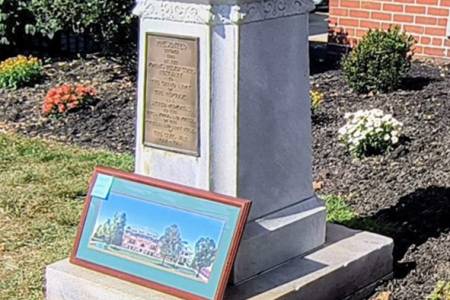 On October 4, 2025 Madison Historical Society of Ohio was able to have their sundial returned after 32 years, when in 1993 it was moved to the lawn of Lake County Courthouse to reduce the chance of vandalism. The sundial was originally placed at Madison Home 100 years ago on Saturday, October 24, 1925 during a conference of the Women's Relief Society. From 1904 to 1962 the state ran this...
On October 4, 2025 Madison Historical Society of Ohio was able to have their sundial returned after 32 years, when in 1993 it was moved to the lawn of Lake County Courthouse to reduce the chance of vandalism. The sundial was originally placed at Madison Home 100 years ago on Saturday, October 24, 1925 during a conference of the Women's Relief Society. From 1904 to 1962 the state ran this...
Elements of Dialing Course - 2025
Monday, 15 September 2025 19:42
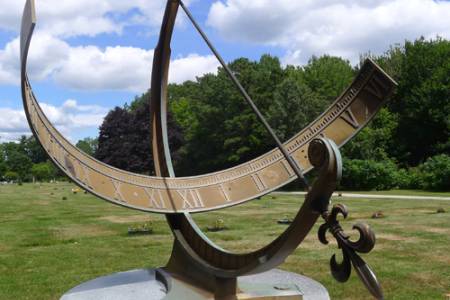 NASS is pleased to announce the upcoming fifth instance of Elements of Dialing, our introductory course about sundials, their history, and the science that makes them work. The free 12-lesson course, intended for those are new to sundialing, runs from 27 October 2025 until 26 April 2026. The course instructor is Robert Kellogg, NASS Vice President and Sundial Registrar. Bob will be...
NASS is pleased to announce the upcoming fifth instance of Elements of Dialing, our introductory course about sundials, their history, and the science that makes them work. The free 12-lesson course, intended for those are new to sundialing, runs from 27 October 2025 until 26 April 2026. The course instructor is Robert Kellogg, NASS Vice President and Sundial Registrar. Bob will be...
Sun Queen of World War II
Thursday, 11 September 2025 23:11
 A Hungarian born American scientist, Mária Telkes (1900-1995), was called "The Sun Queen" and among other honors, was postmousthly inducted into the National Inventors Hall of Fame. She lived to 95 and for most of her life developed solar power in a variety of forms.
Trained as a biophysicist, she worked for Westinghouse Electrical and Manufacturing Company in Pittsburgh, PA, where she...
A Hungarian born American scientist, Mária Telkes (1900-1995), was called "The Sun Queen" and among other honors, was postmousthly inducted into the National Inventors Hall of Fame. She lived to 95 and for most of her life developed solar power in a variety of forms.
Trained as a biophysicist, she worked for Westinghouse Electrical and Manufacturing Company in Pittsburgh, PA, where she...
2025 Conference -Ottawa
Thursday, 28 August 2025 23:25
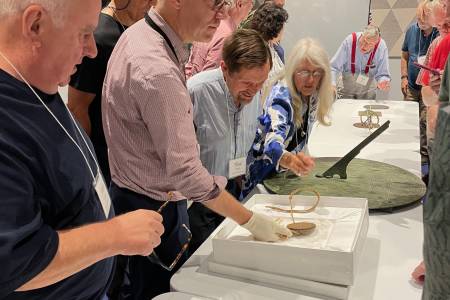 The annual NASS Conference was held 7-10 August, 2025 in Ottawa. As usual, the conference began late Thursday afternoon with an introduction social and a "grab bag give away", taking your chances with tickets to win the bag's prize. Will Grant was the final winner of the Walton Double Planar Polar Sundial, but Paul Ulbrich beat the statistic odds and won this prize three times,...
The annual NASS Conference was held 7-10 August, 2025 in Ottawa. As usual, the conference began late Thursday afternoon with an introduction social and a "grab bag give away", taking your chances with tickets to win the bag's prize. Will Grant was the final winner of the Walton Double Planar Polar Sundial, but Paul Ulbrich beat the statistic odds and won this prize three times,...
Prosciutto di Portici Sundial's Owner
Tuesday, 10 June 2025 18:51
 Prosciutto di Portici (Ham) Sundial
Photo: Getty Images
The Prosciutto di Portici Sundial, more often called the Portici Ham Sundial, dates from the first century somewhere between 8 BCE to 79 CE. This small silvered bronze dial was uncovered on 11 June, 1755 in the ruins of Herculaneum (current day Portici) in the "Villa of the Papyri", buried in...
Prosciutto di Portici (Ham) Sundial
Photo: Getty Images
The Prosciutto di Portici Sundial, more often called the Portici Ham Sundial, dates from the first century somewhere between 8 BCE to 79 CE. This small silvered bronze dial was uncovered on 11 June, 1755 in the ruins of Herculaneum (current day Portici) in the "Villa of the Papyri", buried in...
Hamilton Dial Dedicated
Friday, 06 June 2025 21:01
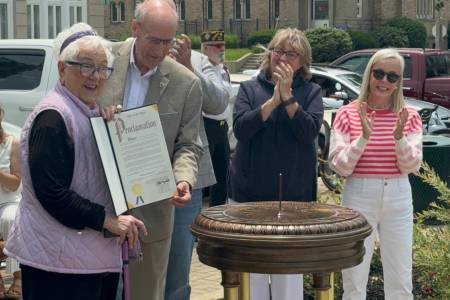 Sundial dedication May 31, 2025. At left is Kathleen Stuckey Fox, with the City Proclamation presented by Mayor Pat Moeller and City Council on-lookers Carla Fiehrer and Susan Vaughn offering congratulations.
On May 31, 2025 at 1pm, the Hamilton, Ohio, sundial (NASS Sundial Registry #1109) was re-dedicated in Monument Park. Originally dedicated in 1941 to the...
Sundial dedication May 31, 2025. At left is Kathleen Stuckey Fox, with the City Proclamation presented by Mayor Pat Moeller and City Council on-lookers Carla Fiehrer and Susan Vaughn offering congratulations.
On May 31, 2025 at 1pm, the Hamilton, Ohio, sundial (NASS Sundial Registry #1109) was re-dedicated in Monument Park. Originally dedicated in 1941 to the...
Frans Maes Received a Royal Decoration
Monday, 24 March 2025 21:33
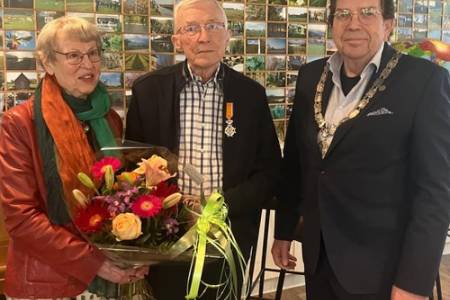 Several years ago Frans decided to write the course on sundials that included self assessment questions to force students not only to read the text, but to internalize the concepts. And a final submittal question "not necessarily a difficult question, but: no answer, no new lesson." Thus Frans Maes began writing lessons and sending them out to students.
NASS has now used his material to create...
Several years ago Frans decided to write the course on sundials that included self assessment questions to force students not only to read the text, but to internalize the concepts. And a final submittal question "not necessarily a difficult question, but: no answer, no new lesson." Thus Frans Maes began writing lessons and sending them out to students.
NASS has now used his material to create...
Pros and Cons of Daylight Savings Time
Monday, 24 March 2025 15:37
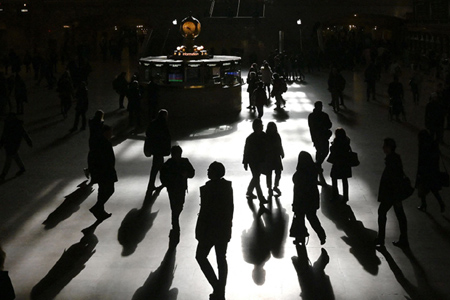 In a 24 March 2025 article from the on-line Science Advisor (American Association for the Advancement of Science) Phie Jacobs summarizes the "great debate" of the yearly shift from standard time to daylight savings time. In January 2025 the US Senate introduced the Sunshine Protection Act to permanently have daylight savings time year round. Certainly 54% of Americans do not like the...
In a 24 March 2025 article from the on-line Science Advisor (American Association for the Advancement of Science) Phie Jacobs summarizes the "great debate" of the yearly shift from standard time to daylight savings time. In January 2025 the US Senate introduced the Sunshine Protection Act to permanently have daylight savings time year round. Certainly 54% of Americans do not like the...
Native American Moon Alignment Ring
Friday, 21 March 2025 19:26
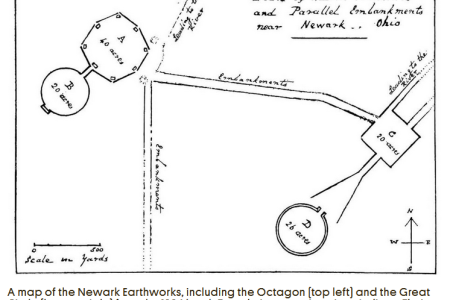 Perhaps the most famous alignment circle in the United States is the Cahokia Woodhenge near St. Louis constructed between 700-1400 CE by Cahokia Indigenous native Americans. But there were an estimated 10,000 other earthen mounds that once were scatter across the mid-west..
In an article from Atlas Obscura (https://www.atlasobscura.com/articles/octagon-earthworks-ohio) by Olivia Young on March...
Perhaps the most famous alignment circle in the United States is the Cahokia Woodhenge near St. Louis constructed between 700-1400 CE by Cahokia Indigenous native Americans. But there were an estimated 10,000 other earthen mounds that once were scatter across the mid-west..
In an article from Atlas Obscura (https://www.atlasobscura.com/articles/octagon-earthworks-ohio) by Olivia Young on March...
Hamilton Dial under Restoration
Friday, 21 March 2025 18:37
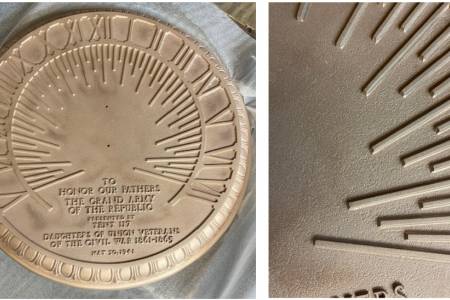 The Hamilton dial is in the restorative care of Jarrett and Celene Hawkins (Hawkins & Hawkins Custom, LLC in Cincinnati Ohio https://www.studio-hawkins.com/) in preparation for the dial's dedication on Saturday, May 31, 2025.
The face of the Hamilton Grand Army of the Republic (GAR) sundial has been cleaned and bead-blasted showing the dial as it was cast 84 years ago. In the process,...
The Hamilton dial is in the restorative care of Jarrett and Celene Hawkins (Hawkins & Hawkins Custom, LLC in Cincinnati Ohio https://www.studio-hawkins.com/) in preparation for the dial's dedication on Saturday, May 31, 2025.
The face of the Hamilton Grand Army of the Republic (GAR) sundial has been cleaned and bead-blasted showing the dial as it was cast 84 years ago. In the process,...
VSSC Space Museum gets Polar Sundial
Tuesday, 17 December 2024 23:47
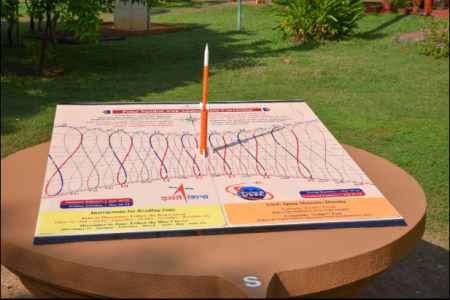 In November 2024, a team consisting of members from SPL, TTDG and CMD of VSSC successfully designed and installed an accurate and fully functional sundial at the Rocket Garden of VSSC Space Museum, Thumba (8.53°N, 76.86°E). Following a space theme, the vertical gnomon is a 3-stage rocket that casts its daily and seasonal shadow on a dial face 1 1/2 meters by 1 meter. The the sundial face...
In November 2024, a team consisting of members from SPL, TTDG and CMD of VSSC successfully designed and installed an accurate and fully functional sundial at the Rocket Garden of VSSC Space Museum, Thumba (8.53°N, 76.86°E). Following a space theme, the vertical gnomon is a 3-stage rocket that casts its daily and seasonal shadow on a dial face 1 1/2 meters by 1 meter. The the sundial face...
Historic Sundials of Andalusia
Saturday, 16 November 2024 00:07
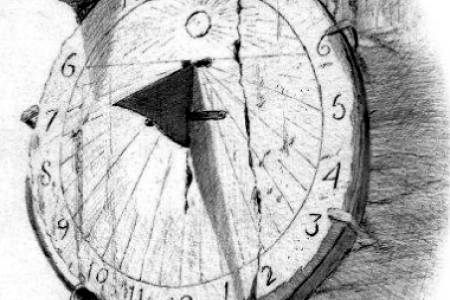 Esteban Martínez Almirón has published a new book Historical Sundials: Forgotten Andalusian Treasures (Relojes de Sol Históricos Tesoros Andaluces Olvidados) In it he reviews over 400 sundials from the Andalucian region of southern Spain Originally to celebrate the 25th year of the website https://relojandalusi.org/
Esteban Martínez Almirón began showing his sundial drawings on the site....
Esteban Martínez Almirón has published a new book Historical Sundials: Forgotten Andalusian Treasures (Relojes de Sol Históricos Tesoros Andaluces Olvidados) In it he reviews over 400 sundials from the Andalucian region of southern Spain Originally to celebrate the 25th year of the website https://relojandalusi.org/
Esteban Martínez Almirón began showing his sundial drawings on the site....
Perryville Eclipse Sundial - 2017
- Details
- Hits: 13351
|
|
In Perryville, Missouri, Perry County unveilled a sundial commemprating the coming August 21st total solar eclipse. Mike Mohundro, Photojournalis for Hearland News (KFVS Channel 12) interviewed Trish Erzfeld, Perry Count Heritage Tourism Director, who said "We just wanted something after the eclipse is over with that the community can be proud of and reflect back on." Mohundro went on to write "many organizations worked on this project together including Earthworks, the [North] American Sundial Society, St. Louis Stone Artist Abraham Mohler, Perry County and more."
The sundial, shown in a KFVS video and in the photo at right, is a horizontal white milk glass sundial now mounted on a large marble pedestal (watch the dial video at http://www.kfvs12.com/story/35969739/perryville-to-commemorate-eclipse-with-sundial).
On the pedestal are three plaques, one entitled "Time" explaining how to convert the sundial's solar time to civil time as told by watches and cellphones. "Not a lot of people know how to read a sundial," Erzfeld said. "It's a teaching tool as well as a historical marker here on out." The second plaque entitled "Eclipse" shows the date and time when the August 21st eclipse starts and stops as seen in Perryville said Don Snyder, local member of the North American Sundial Society. The third plaque "Sundial" indicates who was involved in creating the dial.
Mohundro quotes Erzfeld saying "Education is been our main focus through this whole solar eclipse even... There's just so many things that play into the science of it and a sundial is one of those things that people can learn from."
Solar Eclipse Sundial
- Details
- Hits: 12909
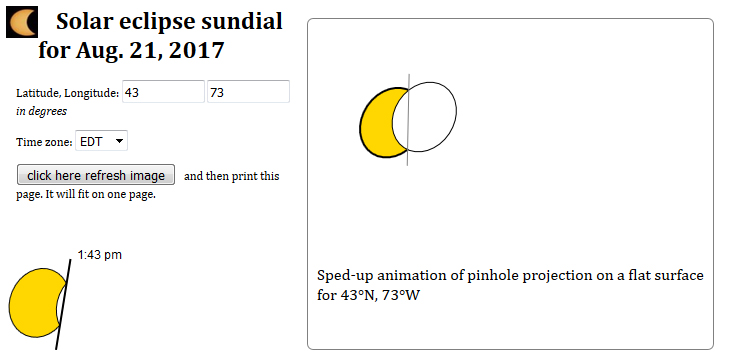 A sundial that only tells time during an eclipse? Back in 2012 Bill Gottesman designed a peculiar dial to tell time by observing the angle between the cusps of the sun during the May 2012 eclipse. Bill Gottesman is back at it with a more sophisticated version assisted by programmer Dan Axtell. This time Bill and Dan give you an animated version of the cusp line, as well as detailed information of the line angle during the eclipse.
A sundial that only tells time during an eclipse? Back in 2012 Bill Gottesman designed a peculiar dial to tell time by observing the angle between the cusps of the sun during the May 2012 eclipse. Bill Gottesman is back at it with a more sophisticated version assisted by programmer Dan Axtell. This time Bill and Dan give you an animated version of the cusp line, as well as detailed information of the line angle during the eclipse.
This is for anywhere in North America that can see the partial or total eclipse. Just enter your latitude and longitude and let the software create you a personal solar eclipse sundial. PLEASE DO NOT OBSERVE THE SUN DIRECTLY WITHOUT AN APPROVED SOLAR FILTER... OR, MAKE A SIMPLE PINHOLE CAMERA FROM A CARDBOARD BOX.
To make your solar eclipse sundial, go to www.eclipsesundial.com
NASS to Observe Eclipse in St. Louis
- Details
- Hits: 13710
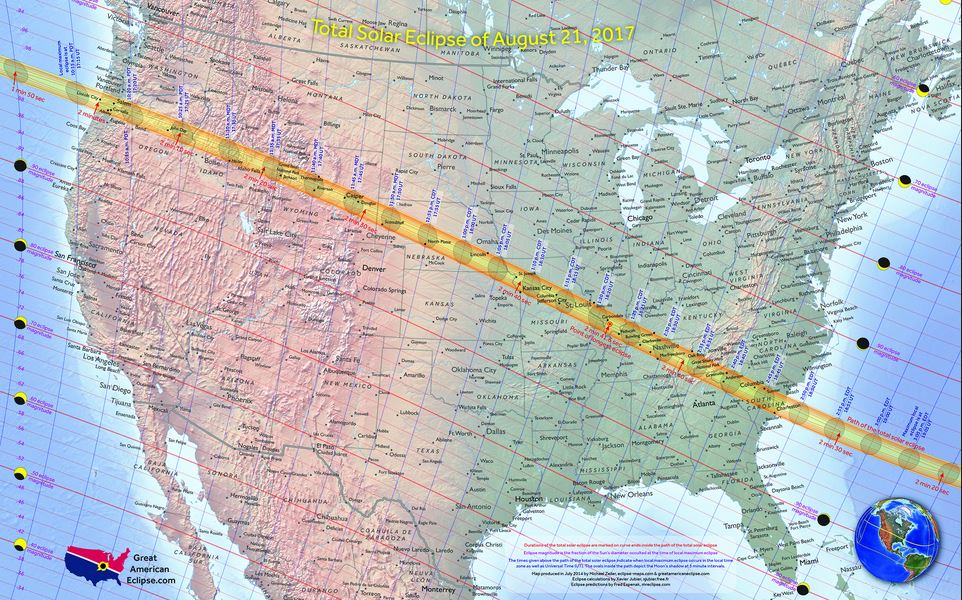 The North American Sundial Society will meet in St. Louis for their annual meeting and to observe the Great American Solar Eclipse on August 21, 2017. Cities and towns across the US are planning events and raising awareness of both the beauty and hazards of the solar eclipse. For the last two years St. Louis groups have delivered more than 100 programs to area schools, libraries, cities, parks and businesses to raise awareness of this historic event which has not happened in St. Louis since the year 1442.
The North American Sundial Society will meet in St. Louis for their annual meeting and to observe the Great American Solar Eclipse on August 21, 2017. Cities and towns across the US are planning events and raising awareness of both the beauty and hazards of the solar eclipse. For the last two years St. Louis groups have delivered more than 100 programs to area schools, libraries, cities, parks and businesses to raise awareness of this historic event which has not happened in St. Louis since the year 1442.
Remember, except for the minute or two of totality, looking directly at the sun will do serious eye damage. Use sun-safe eyeglasses (certified safe for solar viewing) available from many source (see links below or Amazon, etc.). Read about the Great American Eclipse coming near you:
St. Louis, IL: http://stlouiseclipse2017.org/
Other Cities: http://www.eclipse2017.org/2017/in_the_path.htm
US Postal Service to Issue Eclipse Stamp
- Details
- Hits: 14092
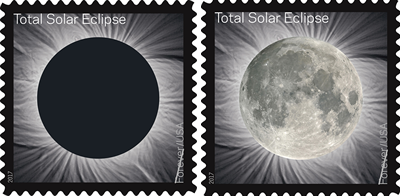 The 2017 August 21st solar eclipse will be commemorated by the US Postal Service with a unique thermochromic ink Forever Stamps: the stamp shows the total Eclipse of the Sun with its corona blocked by a black disk of the moon. However, using the body heat of your thumb or fingers the eclipse image will reveal an underlying image of the moon. The image reverts back to the eclipse once it cools. Fred Espenak, "Mr. Eclipse" a retired NASA astrophysicist, took the photograph of both the eclipse (from Jalu, Libya on March 29, 2006) and the full moon.
The 2017 August 21st solar eclipse will be commemorated by the US Postal Service with a unique thermochromic ink Forever Stamps: the stamp shows the total Eclipse of the Sun with its corona blocked by a black disk of the moon. However, using the body heat of your thumb or fingers the eclipse image will reveal an underlying image of the moon. The image reverts back to the eclipse once it cools. Fred Espenak, "Mr. Eclipse" a retired NASA astrophysicist, took the photograph of both the eclipse (from Jalu, Libya on March 29, 2006) and the full moon.
The USPS states that June 20, 1:30 p.m. MT will be theFirst-Day-of-Issue ceremony, taking place at the Art Museum of the University of Wyoming (UW) in Laramie. The University is celebrating the summer solstice on June 20. Prior to the stamp issuance, visitors are encouraged to arrive at UW's Art Museum's Rotunda at 11:30 a.m. to witness a unique architectural feature at noon when a single beam of sunlight shines from down on a silver dollar embedded in the floor, marking noon on the summer solstice,
The Total Eclipse of the Sun Forever Stamps may be pre-ordered at usps.com/shop in early June for delivery following the June 20 nationwide issuance. The back of the stamp pane provides a map of the eclipse path and times it appears at cities across the US.
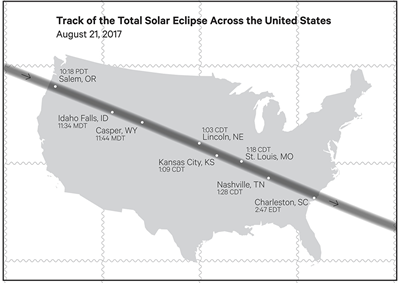
Read more at: NASA Eclipse and for observing tips http://www.mreclipse.com/SEphoto/SEphoto.html
Tour of Time
- Details
- Hits: 13435
At the Grolier Club on the Upper East Side of Manhattan is a massive exhibit On Time: The Quest for Precision curated by Bruce Bradley. The exhibit presents the progress of timekeeping over six centuries through 86 rare books from the Linda Hall Library of Science, Engineering & Technology.
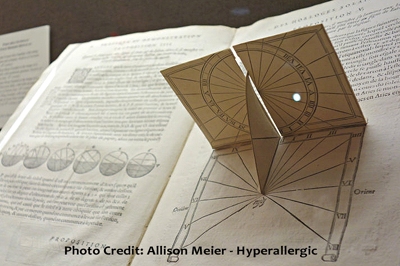
1624 La pratique et demonstration des horloges solaires
|
Journalist Allison Meier of Hyperallergic.com describes a number of books on display such as "German cartographer Sebastian Münster’s 1533 Horologiographia, the first book devoted to sundials, with woodcuts attributed to Hans Holbein the Younger." As shown in her photo, "French engineer Salomon de Caus’s 1624 La pratique et demonstration des horloges solaires has embedded pop-ups to make the workings of its sundials easier to replicate."
The scope of "On Time" stretches from sundials, to water clocks, mechanical clocks and even a Pilkington & Gibbs Heliochronometer, ending with our latest atomic clocks. The display flirts with the possible. While Benjamin Franklin may have suggested using hourly time-telling canon in the 18th century, Athanasius Kircher proposed a fanciful firing sundial a century earlier in his 1646 Ars magna lucis et umbrae in decem libros digesta. His bowl-shaped sundial holds gunpowder at the hours that is ignited by the rays of the sun from a lens. In turn the firing gunpowder triggers hammers to toll hourly bells. If one thinks about this for a moment, Kircher's proposal is as unrealistic as Franklin's. The change in solar declination creates problems for proper placement of the gunpowder, let alone directing the ignition to trigger hammers.
Allison observes that "These manuscripts affirm the centuries of shared ideas that give our modern timekeeping devices their precision." On Time: The Quest for Precision" continues through November 19, 2016.
Read more at: http://hyperallergic.com/327958/on-time-grolier-club-manhattan/
Sundials and Timely Ceremonies
- Details
- Hits: 13652
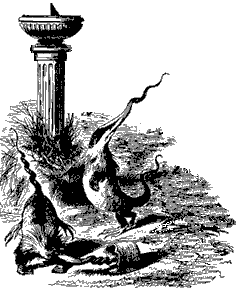 What do Omega Psi Phi fraternity of Howard University Washington DC, Merton College in Oxford, Nashotah House Theological Seminary in Wisconsin, and Lewis Carroll's poem Jabberwocky all have in common? Dancing and ceremonies around a sundial! In Carroll's poem of 1885 "the slithy toves did gyre and gimble in the wabe" and as Alice explains to Humpty Dumpty, “Toves are curious creatures that are something like badgers, something like lizards, and something like corkscrews. They make their nests under sun-dials and live on cheese." and “Wabe is the grass-plot round a sun-dial. It is called like that because it goes a long way before it, and a long way behind it. And a long way beyond it on each side."
What do Omega Psi Phi fraternity of Howard University Washington DC, Merton College in Oxford, Nashotah House Theological Seminary in Wisconsin, and Lewis Carroll's poem Jabberwocky all have in common? Dancing and ceremonies around a sundial! In Carroll's poem of 1885 "the slithy toves did gyre and gimble in the wabe" and as Alice explains to Humpty Dumpty, “Toves are curious creatures that are something like badgers, something like lizards, and something like corkscrews. They make their nests under sun-dials and live on cheese." and “Wabe is the grass-plot round a sun-dial. It is called like that because it goes a long way before it, and a long way behind it. And a long way beyond it on each side."
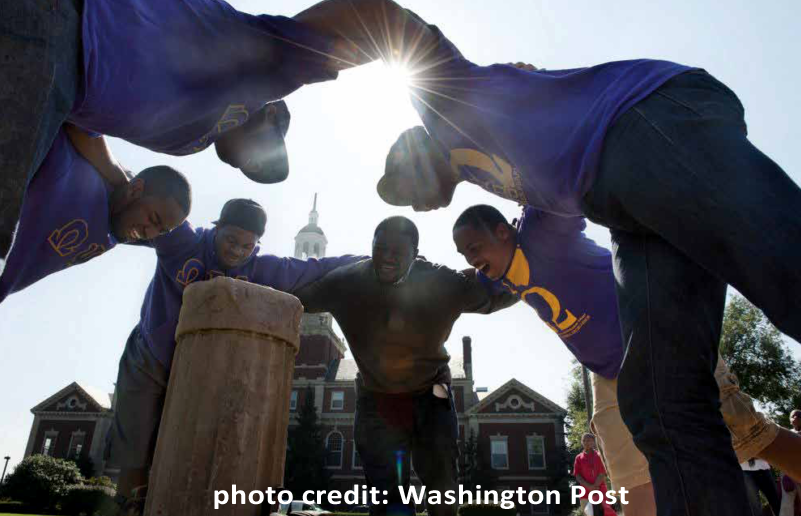 At Howard University in the center of the main campus quadrangle is a bronze sundial on a 3-foot fluted limestone pedestal, gifted in 1929 to the university in honor of Benjamin Banneker, surveyor of the city of Washington DC, clockmaker, and sundialist.
At Howard University in the center of the main campus quadrangle is a bronze sundial on a 3-foot fluted limestone pedestal, gifted in 1929 to the university in honor of Benjamin Banneker, surveyor of the city of Washington DC, clockmaker, and sundialist.
...until the last syllable of recorded time
- Details
- Hits: 11079
 With all due respects to Shakespeare, time will always be with us, and signifies quite a lot. The Harvard-Smithsonian Center for Astrophysics is organizing a symposium dedicated to Time and Culture to be held 5-9 June 2016 at Harvard's Northwest Lab. According to the symposium organizers:
With all due respects to Shakespeare, time will always be with us, and signifies quite a lot. The Harvard-Smithsonian Center for Astrophysics is organizing a symposium dedicated to Time and Culture to be held 5-9 June 2016 at Harvard's Northwest Lab. According to the symposium organizers:
"The symposium aims to set the stage for future timekeeping standards, infrastructure, and engineering best practices for astronomers and the broader society. At the same time the program will be cognizant of the rich history from Harrison's chronometer to today's atomic clocks and pulsar observations. The theoreticians and engineers of time will be brought together with the educators and historians of science, enriching the understanding of time among both experts and the public."
The definition of the second has changed several times over the last 40 years and likely will change again before the end of this decade. Should timekeeping be decoupled from the rotation of the earth? We already abstract time with zone time (such as Eastern Standard Time) and minipulate it to fit our activities (using Eastern Daylight Saving Time). We no longer worry about the moment of sunrise or sunset, rather that we go to work at 9:00AM or have a class that lasts from 10:00-10:50AM. Indeed, "ante and post meridian" may be obsolete.
"The future of timekeeping is evolving with the development of optical frequency standars, the consideration of high-order relativistic effects, and the challenges of distributing trusted timescales at even higher preicision....A closer look at time in astronomy and other sciences, as a defining element of modern civilization, is needed." Read more and register for the symposium at: http://timesymposium.org
Greenwich Globe
- Details
- Hits: 17821
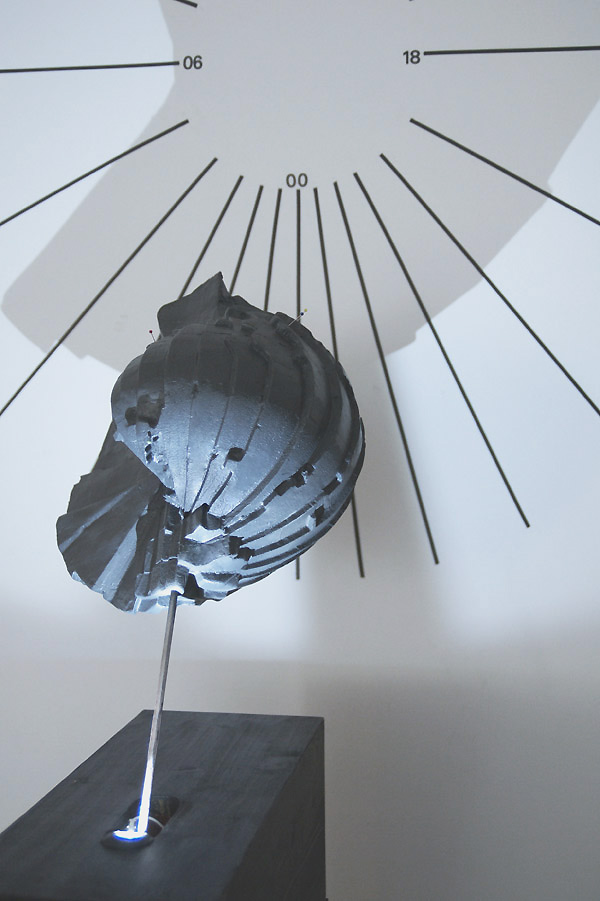 |
Goikhman explains: " The Greenwich Globe's shape was generated by an algorithm that treated time as physical matter. Each additional hour is represented through a constant degree of elevation and a 15o angle bend. The elevation based map projections gives easy-to-read shape to the complex man-made system of time-zones. It also operates as a sundial, a play on the now familiar row of world time clocks. The shadow it casts on a wall is meant to be read as a world watch. Each spike in the shadow shows the local time at a corresponding geographical region."
A History of the Sky
- Details
- Hits: 17137

Kevin Murphy, artist and photographer, set up a time-lapse camera on the roof of the San Francisco Exploratorium to record the sky every 10 seconds, 24 hours per day for an entire year. The camera points due north at and elevation of 45 degrees, which means that you won’t see any dramatic sunrise or sunset, nor will you see a burning image of the sun. Even with the wide-angle lens, the sun is always kept just out of view. But what a wonderful view of the sky: Look closely at the video and you’ll see moving clouds, fog, rain, and differing colors of the sky.
Most stunning is the changing length of the day. Summer morning twilight begins about 4:10am (Pacific Standard Time) and evening twilight ends about 8:10pm, but you must be patient for the winter sky to appear. Winter morning twilight begins about 6:50am (PST) and evening twilight ends about 5:30pm. (There’s a small running clock in the bottom right corner to chart your progress). You’ll see the dramatic difference between summer and winter with days in darkness patiently waiting their turn at sunrise and conversely, the fast quenching of the blue sky into darkness well before the summer frames show any sign of paling.
Each frame is digitally photographed at 1024x768 pixels, that with compression, requires about half a terabyte storage per year. Kevin Murphy has been creative with the sky display: Thumbnail videos of each day of the year are collectively represented in a tiled mosaic 20 days wide by 18 days tall, showing 360 days of sky all at once. The images are arranged chronologically, and are synchronized by time of day, beginning before summer sunrise. Time is compressed in playback at 24 frames/second so that each second represents 4 minutes of time.
This is still a work still in progress: As the camera on the Exploratorium roof continues to collect images of the sky, they will be integrated into the daily montage. Therefore the video will vary from day to day, always displaying the most recent 365 days.
Visit http://www.murphlab.com/hsky/ for more information. Below is his video. It’s best played in full-screen HD resolution. Click the middle arrow to start, then click the bottom right frame box.

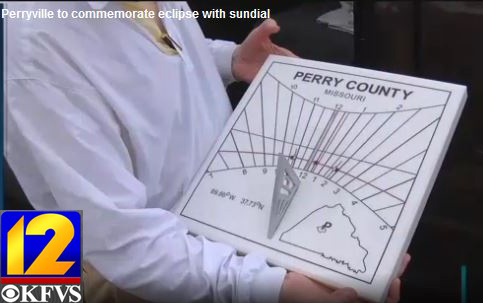 Perryville Eclipse Sundial
Perryville Eclipse Sundial